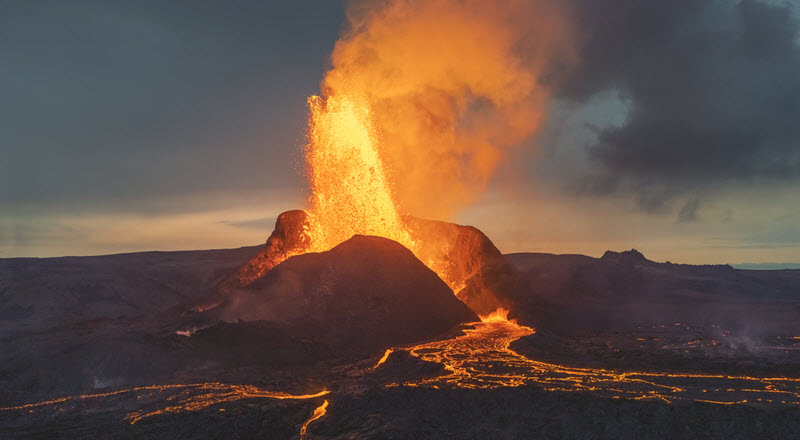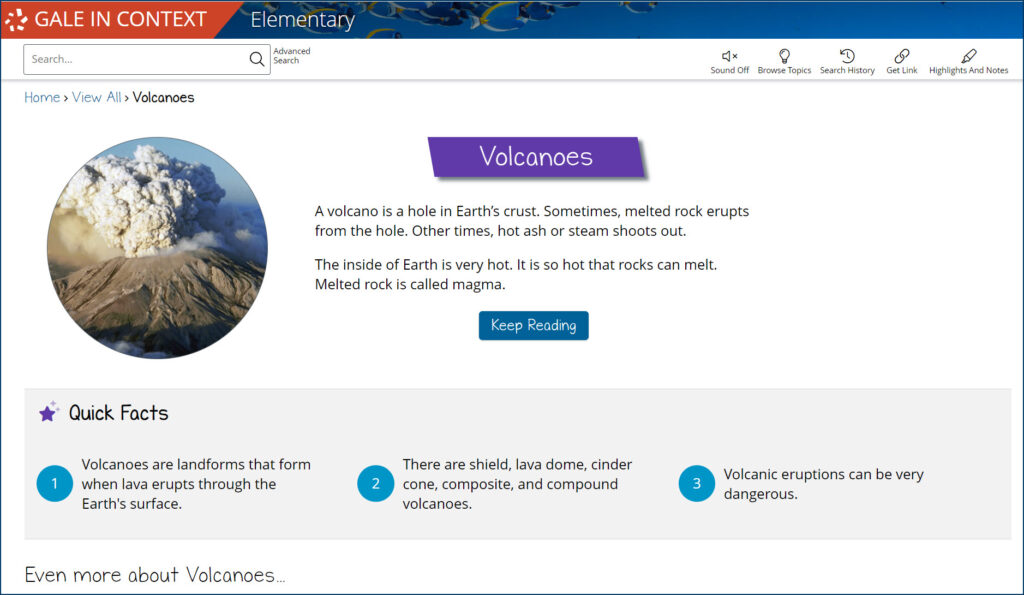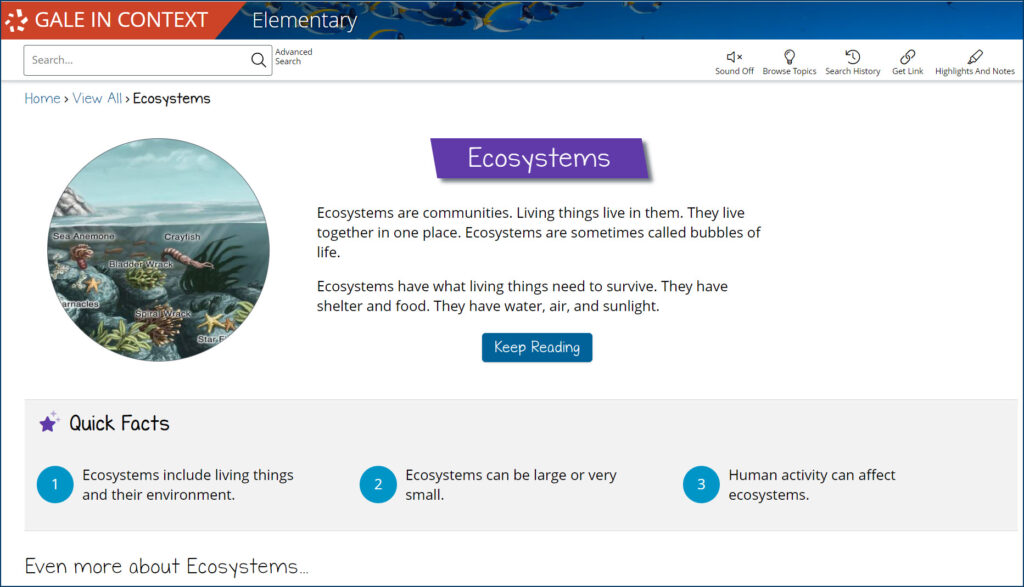The sheer power of a volcanic eruption is awe-inspiring. A single event can release more energy than a nuclear explosion. When unleashed, that immense power can instantly reshape landscapes, sculpt mountains, form islands, and redirect rivers.
Yet, in the wake of their destructive fiery, volcanoes breathe new life into the surrounding land. As the Earth begins to heal, the ash that choked the air and obscured the sun settles back into the soil, creating a fertile foundation from which new ecosystems spring.
Educators can turn to Gale In Context: Elementary’s volcano topic page to deepen students’ understanding of these powerful natural events. This all-encompassing resource brings the science of volcanoes to life with its extensive collection of vibrant images, engaging articles, and age-appropriate content. Start with the volcanoes topic page!
Covering the Basics: How Volcanos Work
Before discussing volcanoes, elementary school students must first understand magma—a hot, semi-liquid mixture of molten rock and dissolved gases that form in the mantle below the Earth’s crust. Because the mantle is so incredibly hot and at such a high pressure, rocks melt into magma, pushing against the crust above it.
Over time, that pressure builds until the magma needs to escape, like a pot on the stove. If you leave the lid on too long, the steam builds up until the lid starts to rattle and the liquid boils over. Similarly, when the pressure under the Earth’s crust becomes too great, the magma forces its way through weak spots, creating volcanoes.
Types of Volcanic Eruptions
Once magma reaches the surface, it is then referred to as lava, which can flow out of the volcano in several ways.
In some cases, the lava has a low viscosity, meaning it’s thin and flows easily, resulting in an effusive eruption. As the lava oozes out, it spreads slowly to form broad, gentle slopes like those in shield volcanoes like Mauna Loa and Kīlauea in Hawaii.
Another type is an explosive eruption, which is more violent because the magma is highly viscous due to increased trapped gases. When the magma suddenly releases, it does so under tremendous force, which throws tephra—ash, gases, and volcanic rocks—high into the atmosphere. The U.S. experienced an explosive eruption from Mount St. Helens in 1980.
Finally, phreatomagmatic eruptions require the magma to come into contact with water. This sudden mixture of hot magma and cool water creates steam, increases the pressure, and leads to an even more violent explosion. With a phreatomagmatic explosion, volcanoes produce base surges or ground-hugging waves of hot gas and debris that move at high speeds.
The Different Forms of Volcanoes
Depending on the types of explosions a volcano has, they can take on unique shapes:
- Shield volcanoes, like Mauna Loa and Kīlauea in Hawaii and Surtsey in Iceland, have broad sides formed by the flow of low-viscosity lava that spreads out over great distances.
- Composite or stratovolcanoes are tall and conical formations built up by many hardened layers of lava, tephra, pumice, and ash. These tend to produce explosive eruptions, like those of Mount Fuji, Japan, and Mount Vesuvius, Italy.
- Cinder cone volcanoes are steep, cone-shaped hills of volcanic degree that build up around a single vent. They’re the smallest, simplest form, with examples including Parícutin, Mexico, and Sunset Crater, Arizona.
- Lava dome volcanoes, such as Novarupta Dome in Alaska and Valles Caldera in New Mexico, form from the slow leakage of highly viscous lava, which creates a rounded structure.
Activity Idea: You can see what your learners remember from lessons on the different types of volcanos by challenging them to complete the “What kind of volcano am I?” activity. Encourage your students to use the Gale In Context: Elementary search function to thoroughly research the different volcanos before choosing the correct formation.
Eruptions and Their Aftermath: The Renewal Cycles of Volcanic Activity
When most people think about a volcanic event, they associate it with destruction and devastation. This perspective is understandable, but students should know that it’s just another example of the Earth’s natural cycles. These cataclysmic eruptions renew the surrounding ecosystem and coax new life to emerge.
Gale In Context: Elementary provides extensive resources through its volcano topic portal. This library of information encourages students to explore the natural world while prioritizing children’s developmental needs through adjustable reading levels and ReadSpeaker technology.
Mount Vesuvius: Fertile Grounds From Ancient Ash
In 79 BCE, Mount Vesuvius—the only active volcano in continental Europe—buried the Roman cities of Pompeii and Herculaneum under feet of cinders and ash. While the number of deaths is uncertain, ranging from 2,300 to 16,000, what we do know is that magma wasn’t the culprit. Instead, Vesuvius burped up clouds of toxic gases and tossed rocks out of its crater for days before the final cloud of hot ash swept through the town so quickly that it preserved everything from human beings and dogs to the fresh paint on murals.
This event is the first detailed recorded volcanic eruption in history, thanks to Pliny the Younger, a Roman politician and author who escaped the city. Gale In Context: Elementary provides a simplified, translated version of Pliny’s letter appropriate for younger readers.
Students can glimpse Pliny’s firsthand account as he describes, “Now came the dust, though still thinly. I look back: A dense cloud looms behind us, following us like a flood poured across the land . . . The fire itself actually stopped some distance away, but darkness and ashes came again, a great weight of them. The sight that met our still terrified eyes was a changed world—buried in ash like snow.”
In the immediate aftermath, the lands around Vesuvius were uninhabitable, and Pompeii went undiscovered for centuries. However, the volcanic ash enriched the soil, making the area incredibly fertile. Today, those slopes nurture some of Italy’s most productive grape vineyards and olive orchards.
Mount St. Helens: Recovering Life in the Cascades
The United States has nearly 170 volcanos, with Mount St. Helens being the most active in the contiguous U.S. The eruption in 1980 was particularly violent, flattening the surrounding forest and covering the area in a river of hot gas, ash, and rock known as a pyroclastic flow.
However, this seemingly barren wasteland didn’t remain that way for long. The first signs of life returned surprisingly quickly, with pioneering species like lupines taking root in the ash-covered ground, helping to stabilize the soil and welcome other plants. New plant life meant that herbivores could return to the area, with larger predators following.
Over the decades, the Mount St. Helens eruption zone has become a living laboratory for studying natural regeneration and how ecosystems rebound after significant disturbances.
Mount Tambora: Turning Desolation Into Ecological Diversity
When Mount Tambora in Indonesia erupted in 1815, its far-reaching effects disrupted global climates and led to what is now known as the “year without a summer.” The immediate aftermath in the region surrounding Tambora was catastrophic, with entire forests incinerated and villages buried under several feet of ash. It was a lifeless expanse, seemingly inhospitable to any form of life.
Yet, the landscape began to undergo a remarkable transformation, with the uneven distribution of ash and pumice creating a variety of microhabitats—small, distinct environments where different plant and animal species could take hold.
Once the pioneering grasses and shrubs set down roots and enriched the soil with organic matter, more complex lifeforms established themselves. Dense rainforests began reclaiming the volcano’s lower slopes, becoming a refuge for species like the yellow-crested cockatoo, Celebes crested macaque, and Sumba round leaf bat. In contrast, the areas with less fertile soil turned into grasslands and savannahs that support herbivores, such as the Javan rusa.
Activity Idea: Ask students to research the ecosystems surrounding a volcano of their choice from the list of “famous volcanic eruptions.” As the students explore the diverse flora and fauna that have adapted to life near their chosen volcano, instruct them to gather information to prepare a visual presentation showcasing how these ecosystems have evolved over time.
Bring Dynamic Science Content to Your Classroom With Gale In Context: Elementary
Volcanoes are a compelling gateway to invite elementary students to engage with the forces shaping our world and begin to appreciate the resilience of the Earth’s ecosystems. Gale In Context: Elementary is designed to make these learning experiences meaningful and memorable for young students, helping you transform complex scientific concepts into engaging, hands-on lessons that resonate with curious minds.
Want to see how Gale In Context: Elementary can inspire your students? Learn more or request a trial!



